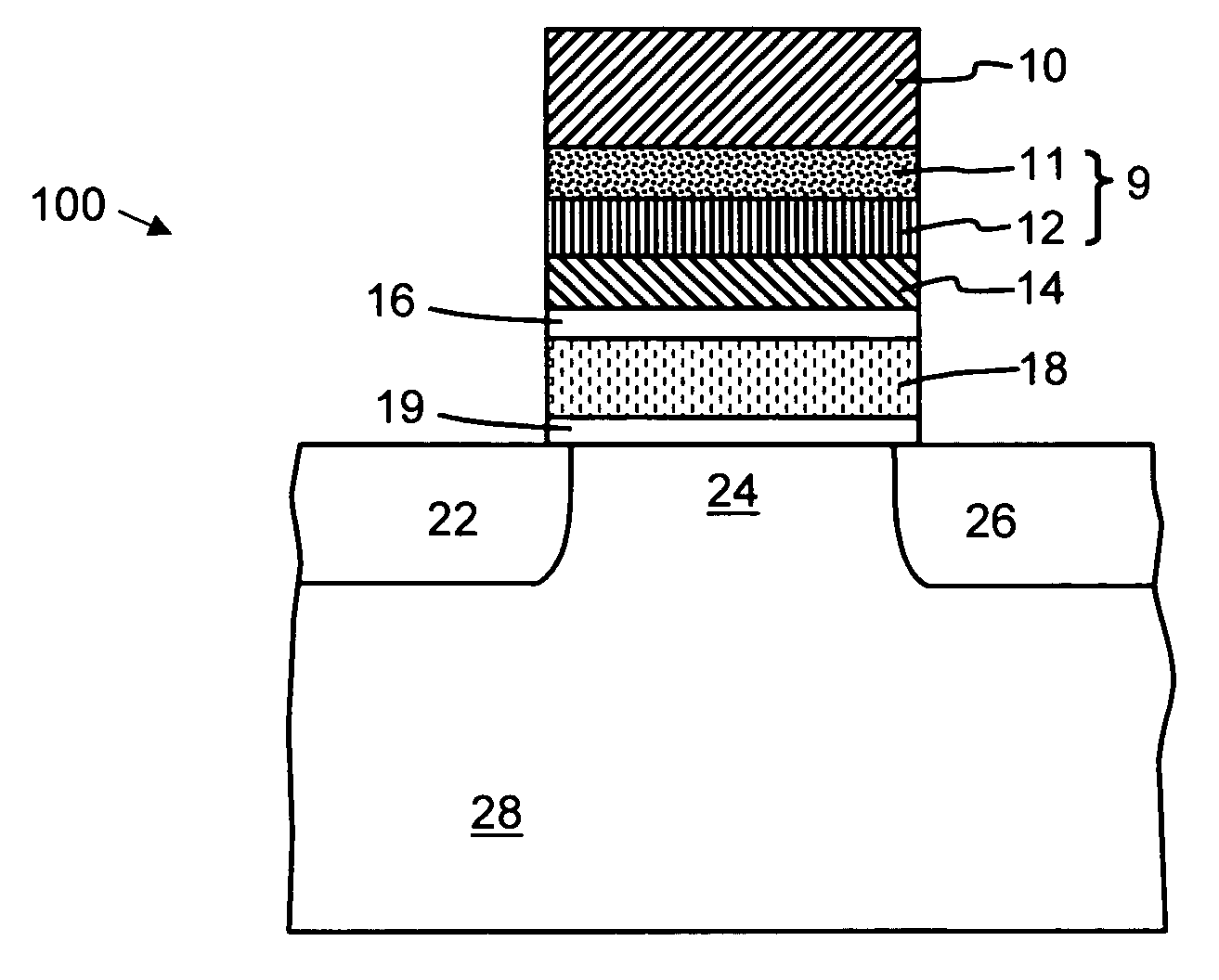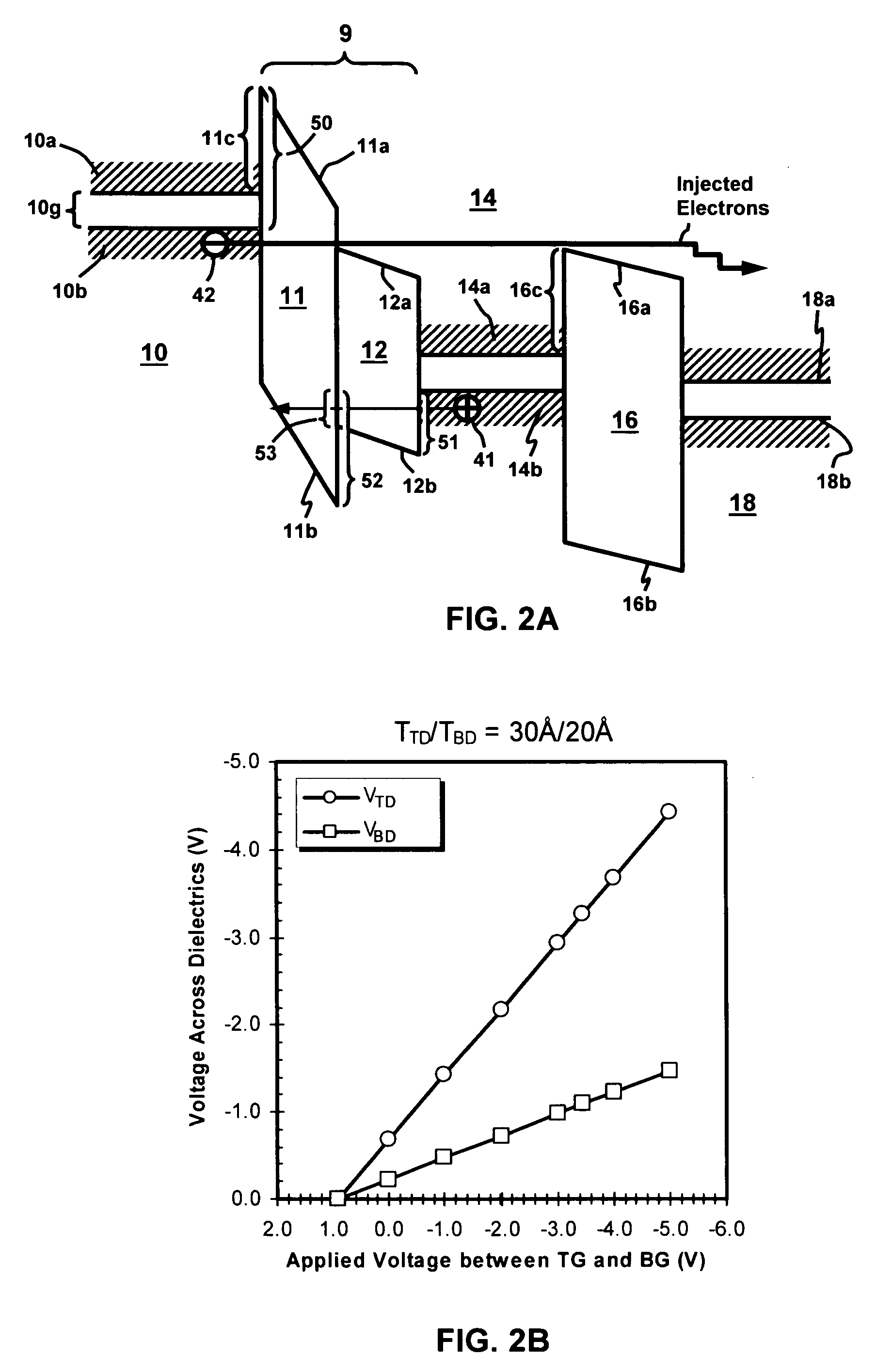Electrically alterable memory cell
a memory cell and electric field technology, applied in the direction of semiconductor devices, electrical apparatus, transistors, etc., to achieve the effect of suppressing the large c
- Summary
- Abstract
- Description
- Claims
- Application Information
AI Technical Summary
Benefits of technology
Problems solved by technology
Method used
Image
Examples
embodiment 100
Embodiment 100
[0047] As used herein, the symbol n+ indicates a heavily doped n-type semiconductor material typically having a doping level of n-type impurities (e.g. arsenic) on the order of 1020 atoms / cm3. The symbol p+ indicates a heavily doped p-type semiconductor material typically having a doping level of p-type impurities (e.g. boron) on the order of 1020 atoms / cm3.
[0048]FIG. 1A shows a cross-sectional view of cell architecture 100 in accordance with one embodiment of the present invention. There is shown a tunneling gate (TG 10), a filter 9, a ballistic gate (BG 14), a floating gate (FG 18), a source 22, a channel 24, a drain 26, and a body 28 in a semiconductor substrate (such as a silicon substrate or a silicon-on-insulator substrate). The filter 9 comprises a tunneling dielectric (TD 11) and a blocking dielectric (BD 12). The TD 11 is sandwiched in between the TG 10 and the BD 12 regions. Likewise, the BD 12 is sandwiched in between the TD 11 and the BG 14 regions. The BG...
embodiment 200
Embodiment 200
[0125]FIGS. 11A and 11B provide respectively a cell structure 200 and an energy band diagram in the flat-band condition for another embodiment of the present invention. The memory cell 200 of FIG. 11A is similar to the one illustrated in FIG. 1A except with a difference on the filter 9 structure in between TG 10 and BG 14. These differences are described herein. Referring to FIG. 11A, there is shown a filter 9 comprising an upper tunneling dielectric (UTD 71), a lower tunneling dielectric (LTD 72), and a blocking material (BM 73) disposed therebetween. The UTD 71 can be a dielectric material such as oxide or any other materials considered in connection with TD 11 of cell 100. The LTD 72 can be a dielectric having a lower energy gap and a higher dielectric constant than that of UTD 71. In general, the materials for UTD 71 and LTD 72 should be high quality dielectrics permitting charge carriers to transport therethrough from one side of the dielectric to the other in qua...
embodiment 300
Embodiment 300
[0130] Provided in FIG. 12A is a similar cell structure as in FIG. 11A except by replacing the BM 73 of FIG. 11A with a plurality of blocking nano-crystals (BNC 74) each having energy gap comparable or larger than that of TG 10. The BNC 74 can be in a ball shape with a diameter in the range comparable to the wavelength of charge carriers (i.e. electrons or holes). Typical range of the diameter is about 30 Å to about 200 Å. The nano-crystals 74 can be formed by Ultra-High-Vacuum Chemical-Vapor-Deposition (“UHVCVD”) technique well-known in the art. The nano-crystal functions as an “island” between TG 10 and BG 14 to permit charge carriers hopping therethrough. In specific, as a proper bias is applied between TG 10 and BG 14, charge carriers in TG 10 are emitted through tunneling mechanism onto BNC 74 and subsequently tunneling into the BG 14. The cell structure comprises two types of zone. The first type of zone contains a nano-crystal 74 in between TG 10 and BG 14 (for ...
PUM
 Login to View More
Login to View More Abstract
Description
Claims
Application Information
 Login to View More
Login to View More - R&D
- Intellectual Property
- Life Sciences
- Materials
- Tech Scout
- Unparalleled Data Quality
- Higher Quality Content
- 60% Fewer Hallucinations
Browse by: Latest US Patents, China's latest patents, Technical Efficacy Thesaurus, Application Domain, Technology Topic, Popular Technical Reports.
© 2025 PatSnap. All rights reserved.Legal|Privacy policy|Modern Slavery Act Transparency Statement|Sitemap|About US| Contact US: help@patsnap.com



